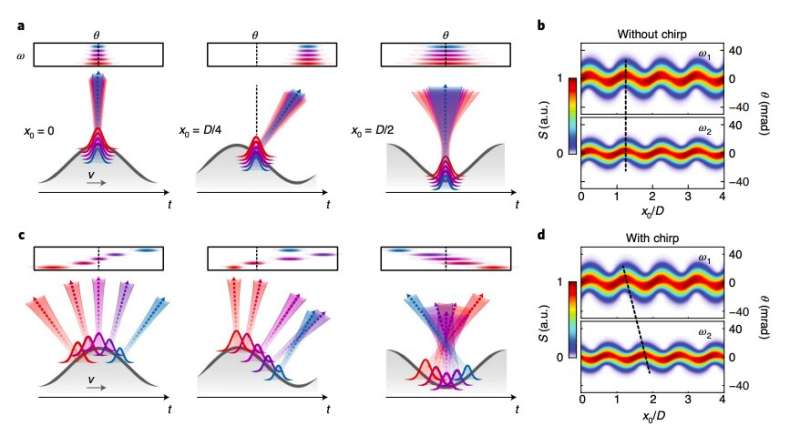
The principle underlying dynamical ptychography
Posted on 07/19/2021 6:07:48 PM PDT by LibWhacker

The principle underlying dynamical ptychography
One of the topics investigated in recent physics studies is strong-field quantum electrodynamics (SF-QED). So far, this area has rarely been explored before, mainly because the experimental observation of SF-QED processes would require extremely high light intensities (>1025W/cm2), over three orders of magnitude higher than those attained using the most intense PetaWatt (PW)-class lasers available today.
A SF-QED process that has proved to be particularly difficult to observe is the Schwinger process. This is a process that occurs close to the so-called Schwinger limit (1029/cm2), which is associated with the optical breakdown of the quantum vacuum and the production of prolific electron/positron pair plasmas.
To observe the Schwinger process, as well as other SF-QED processes, physicists would need to be able to reach light intensities above 1025W/cm2 and up to 1029/cm2. One possible way to produce these strong light fields could be to reflect high-power laser pulses off a curved relativistic mirror, mirrors in plasmas that consist of thin dense electron layers accelerated by high-intensity electromagnetic waves.
Researchers at the Lasers Interactions and Dynamics Laboratory (LIDYL) of the French Atomic Energy Commission (CEA) have recently proved that such curved relativistic mirrors can be produced when a very intense laser pulse ionizes a solid target and creates a dense plasma that reflects incident light. Their paper, published in Nature Physics, could have important implications for future research aimed at observing SF-QED processes.
"Recently, our group proposed a new way to significantly boost the intensities of present high-power lasers by more than three orders of magnitude, using remarkable optical elements called 'relativistic plasma mirrors'," Henri Vincenti, one of the researchers who carried out the study, told Phys.org. "These mirrors can be obtained by focusing a high-power laser on an initially solid and optically flat target."
Essentially, Vincenti and his colleagues theorized that when a high-power laser is focused on an initially solid, optically flat target, it creates a dense plasma at laser focus. This plasma can specularly reflect the incident light.
"Upon reflection on this 'plasma mirror', the laser electric field makes its surface oscillate at relativistic velocities, thus forming what we call a relativistic oscillating mirror (ROM)," Vincenti said. "This ROM periodically compresses the reflected light in turns via the so-called Doppler effect. This periodic compression yields a train of sub-femtosecond or attosecond light pulses, associated to a Doppler harmonic spectrum in the frequency domain."
In addition to this 'temporal compression', the incident laser beam induces a spatially inhomogeneous radiation pressure on the surface of the plasma mirror, where the intensity of the laser is higher at center of the laser's focal point than on the edges. This radiation pressure ultimately curves the plasma mirror's surface. This observation could thus open up new possibilities for the exploration of SF-QED processes in experiments using laser technology.
"The primary objective of our recent work was to show that ROM curved by radiation pressure can temporally compress a high-power laser and focus the Doppler-upshifted harmonic content with excellent optical quality," Vincenti said. "To achieve this, we propose a new measurement technique to fully characterize the spatio-temporal profile of the reflected light from a plasma mirror in experiments."
The initial goal of the recent study by Quéré, Vincenti and their colleagues was to characterize the spatio-temporal properties of plasma-mirror light sources, to enable their use in experiments. The characterization of these properties would, for instance, allow researchers to focus plasma-mirror light sources on matter samples to reach SF-QED dominated regimes or use them to perform attosecond pump-probe experiments and probe electron dynamics in atoms. In addition, the researchers hoped that their work would enable the comparison of measurements collected in past experiments with existing theoretical and numerical models of plasma mirror sources.
"Up until now, measurements techniques were only able to retrieve either temporal information or spatial information but not both simultaneously," Vincenti said. "For spatial information, a common technique used is called 'ptychography' and allows a complete spatial characterization of a light source at different wavelength."
Ptychography allows researchers to achieve a complete spatial characterization of light sources by placing an object in the near field scanned through a light beam at different positions across a given plane. By examining the evolution of the diffraction pattern in the far field, as a function of the object's position in the plane, potentially using a phase retrieval algorithm, researchers can retrieve the spatial amplitude and phase of both the object and light source.
While many physicists have used ptychography in the past, this technique does not typically allow researchers to retrieve temporal information, as the object placed in the near field is fixed. Quéré, Vincenti and their colleagues thus devised an alternative technique that would allow physicists to also retrieve temporal information about the object and light source. This technique entails the creation of a ptychographic object that can move on the attosecond time scale, enabling the retrieval of both spatial and temporal information.
"This object can be obtained by using a second light beam of frequency 2 omega (omega being the frequency of the main laser pulse) focused at an angle with respect to the main laser beam," Quéré said. "By scanning the delay between the two beams, one can change the position of the object with respect to the emission time of the successive attosecond pulses emitted by the plasma mirror. A phase retrieval algorithm can then be obtained to retrieve the full spatio-temporal profile of the light reflected by the plasma mirror."
Using the technique they developed, dubbed 'dynamycal ptychography', Quéré and his colleagues were able to retrieve the spatio-temporal amplitude and phase profile of attosecond pulses emitted by plasma mirrors at both moderate and ultra-high intensities.
Ultimately, the technique proposed by this team of researchers could aid the quest to reach high light intensities using plasma mirrors. For instance, it could help physicists to estimate the intensity that can be achieved using plasma mirrors with high levels of accuracy, while also allowing them to correlate these measurements with the SF-QED processes observed in past experiments (e.g., electron/positron pairs, gamma rays, etc.).
"So far, we have successfully applied dynamical ptychography to 100TeraWatt-class lasers," Vincenti said. "The next important milestone will be to implement it on PW-class laser facilities, on which the intensity boosting by relativistic plasma mirrors is expected to be orders of magnitude higher."
'Course I DID NOT understand this article well enough to make such a speculative leap. But what do you think? Could this revolutionize the capabilities of our armed forces overnight, or is this something that will only make it out of the lab years or decades from now? Like fusion?
bkmk
Not in the real world
While this achievement is a big deal they are orders of magnitude away from reaching the desired goal
I guess you had to be there.
Sounds like a quantum hologram.
RE: Not in the real world.
But my pickup already has on the passenger side mirror:
High-power laser pulses are closer than they appear in this curved relativistic mirror.
Could this also be use for powering “solar sails”?

Lol, exactly! This article lost me early and just kept on repeating that feat every other sentence or two.
Unfortunately, using this technique will result in blowing a hole in this spacetime context and an adjacent one, sucking everything into it at relativistic speeds in such a manner that the event horizon will approach so quickly that you won’t even know that it ha
Nice try but nope
This technique doesn’t create power, it focuses it. They are working with terawatt and looking at petawatt pulses, but those pulses are incredibly short and the pulse repetition frequency is probably not high. Therefore the average power is probably low.
To get battlefield effects you need high average power as opposed to high instantaneous power. The lasers which can be practically powered on the battlefield are in the kilowatt range, possibly ranging up to low megawatt range.
Disclaimer: Opinions posted on Free Republic are those of the individual posters and do not necessarily represent the opinion of Free Republic or its management. All materials posted herein are protected by copyright law and the exemption for fair use of copyrighted works.